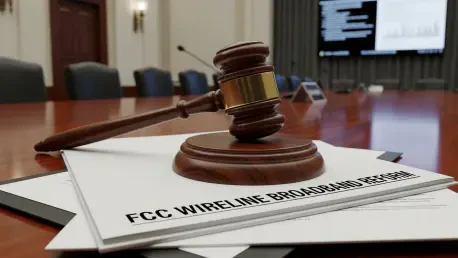The digital divide in the United States remains a stubborn challenge, with millions still lacking access to reliable broadband, especially in rural and underserved areas, and as federal initiatives like the Broadband Equity, Access, and Deployment (BEAD) program roll out billions in funding to bridge this gap, a critical bottleneck threatens progress: the permitting process for wireline deployment. Inconsistent timelines, excessive fees, and fragmented coordination across jurisdictions are stalling projects at a time when connectivity is more vital than ever. This roundup gathers insights from industry stakeholders and trade groups to explore whether the Federal Communications Commission (FCC) can drive reforms to accelerate wireline broadband expansion. The discussion aims to unpack diverse perspectives on the barriers and potential solutions shaping the future of national internet access.
Unpacking the Permitting Challenges in Wireline Expansion
Industry voices have long pointed to the permitting process as a major hurdle in deploying wireline broadband infrastructure. Trade associations representing telecom providers argue that erratic approval schedules and bureaucratic red tape at state and local levels create delays that can span months, risking missed deadlines for federal funding. One prominent group has highlighted how these inefficiencies undermine efforts to meet pressing connectivity goals, especially with the urgency of large-scale funding programs on the horizon.
Another perspective emphasizes the legal framework guiding potential reform, specifically the FCC’s ongoing inquiry into eliminating barriers to wireline deployment. This initiative, rooted in federal communications law, seeks to address local regulations that hinder progress by exploring preemption of restrictive policies. Stakeholders see this as a pivotal opportunity for the FCC to establish clearer guidelines that could streamline project timelines across diverse regions.
The conversation also touches on the broader implications of these challenges. With emerging technologies like artificial intelligence (AI) demanding robust network infrastructure, the stakes for swift deployment are higher than ever. Input from various industry players suggests that without significant permitting reform, the cost and time required to expand broadband could widen existing disparities, leaving some communities further behind in the digital economy.
Diving Deep into Permitting Barriers and Proposed Solutions
Navigating the Maze of Inconsistent Approval Timelines
A recurring concern among broadband providers is the lack of standardized permitting schedules, which can vary wildly between jurisdictions. Industry advocates have proposed the adoption of strict “shot clocks,” suggesting approval windows of 60 to 90 days to prevent projects from languishing indefinitely. This push for uniformity stems from widespread reports of delays that jeopardize critical funding timelines tied to national connectivity programs.
Specific cases illustrate the severity of these setbacks. In certain states, providers have encountered approval processes stretched beyond five months due to rigid local rules, such as mandatory public notice periods that reset if a single deadline is missed. Such unpredictability not only frustrates deployment efforts but also risks derailing federally supported initiatives, as funding often comes with strict completion deadlines.
Balancing federal mandates with local autonomy adds another layer of complexity to this issue. While some stakeholders argue that national timelines are essential for consistency, others caution that overriding local control could spark resistance from municipalities. The tension lies in ensuring that standardized rules do not alienate communities whose input remains vital to the deployment process, raising questions about how best to align diverse interests.
Tackling the Burden of Excessive Permitting Fees
Financial barriers pose another significant obstacle, with arbitrary permitting costs often deterring providers from pursuing projects, particularly in less profitable areas. Industry groups have called for transparent, cost-based fee structures, arguing that charges should reflect actual expenses rather than serving as revenue streams for local governments. This reform is seen as crucial to making broadband expansion viable in underserved regions.
Examples of prohibitive fees underscore the urgency of this issue. In one Midwestern city, a provider faced a staggering $63,000 permit fee for a small fiber project, ultimately forcing abandonment of the plan. Comparisons to the FCC’s past success in curbing excessive fees for 5G deployment suggest that a similar approach could alleviate financial strain in wireline projects, offering a precedent for actionable change.
The potential impact of high costs on the digital divide cannot be overlooked. When fees become insurmountable, projects in rural or low-income areas are often the first to be shelved, exacerbating connectivity gaps. However, local governments may resist fee reductions, citing budget constraints, which highlights the need for a balanced framework that addresses both provider concerns and municipal needs.
Streamlining Processes Through Unified Coordination
Fragmented permitting systems across jurisdictions create inefficiencies that compound delays and costs, according to industry feedback. Advocates have proposed solutions like one-stop permitting portals and standardized application forms to simplify the process for providers navigating multiple local rules. Such measures could reduce administrative burdens and foster smoother project execution.
Practical benefits of streamlined coordination are evident in industry trends, with smaller cable providers echoing the call for unified review processes. Yet, real-world bottlenecks persist, such as in some Southern cities where redundant certification requirements slow progress. These examples illustrate how inconsistent practices hinder deployment and underline the demand for harmonized systems.
The role of federal preemption in achieving coordination remains a point of debate. While some stakeholders believe FCC intervention is necessary to override disparate local policies, others question whether this approach risks undermining community authority. Technological solutions, such as digital platforms for permit tracking, are also floated as potential tools to bridge gaps without heavy-handed federal mandates.
Meeting the Urgency of Modern Connectivity Needs
The timing of permitting reform is critical, given the rollout of substantial federal funds for broadband and the infrastructure demands of cutting-edge technologies. Industry input stresses that delays in wireline deployment could jeopardize the effective use of these funds, particularly in regions where connectivity is most needed. The intersection of policy and innovation adds urgency to resolving these longstanding issues.
Regional disparities further complicate the landscape, with some areas facing far greater permitting challenges than others. Stakeholders suggest that FCC action could set a national precedent, creating a cohesive framework for future initiatives. This perspective frames permitting reform as not just a current necessity but a foundation for long-term digital equity.
Questions also arise about whether local governance always aligns with community interests in the context of broadband expansion. Some industry voices argue that federal oversight might better serve national priorities, especially when local delays hinder broader connectivity goals. This viewpoint challenges traditional assumptions about the balance of power in infrastructure planning.
Key Insights and Practical Strategies for Permitting Reform
Synthesizing the input from various industry players reveals core issues of prolonged delays, unreasonable fees, and inconsistent practices as central to the permitting crisis. Trade groups collectively assert that FCC-led reforms could transform the landscape by introducing predictability and fairness, potentially accelerating wireline deployment nationwide. Their unified stance underscores the scale of the problem and the need for decisive action.
Actionable steps emerge from this dialogue, including a push for stakeholders to advocate for uniform approval timelines and transparent cost structures in feedback to regulatory bodies. Encouraging public-private collaboration on these fronts could build momentum for change, ensuring that proposed reforms gain traction at both federal and local levels.
Additionally, broadband providers and policymakers are urged to explore pilot programs for streamlined permitting processes. Testing innovative approaches in select regions could provide data to refine national strategies, paving the way for scalable solutions. This collaborative effort is seen as a pragmatic path to overcoming entrenched barriers while minimizing disruption.
The Road Ahead for Wireline Deployment and FCC Involvement
Looking back, the roundup of perspectives from industry stakeholders painted a vivid picture of the permitting challenges that slowed wireline broadband deployment across the United States. Discussions revealed a shared frustration with delays, costs, and fragmented systems, alongside a strong consensus on the need for FCC intervention to drive meaningful reform. The urgency tied to federal funding and technological advancements framed these insights as more than theoretical—they were rooted in real-world stakes.
Moving forward, a key next step lies in fostering dialogue between providers, local governments, and federal agencies to craft balanced policies that address diverse needs. Exploring hybrid models that blend federal guidelines with local input could mitigate resistance while ensuring progress. Additionally, investing in technology to digitize and standardize permitting workflows offers a forward-thinking solution to reduce friction.
Beyond immediate reforms, sustained advocacy for digital equity must remain a priority. Stakeholders should continue monitoring FCC actions and push for frameworks that adapt to evolving connectivity demands over the coming years, from 2025 onward. By staying engaged, the industry can help shape a future where broadband access is not just a goal but a reality for all communities.









